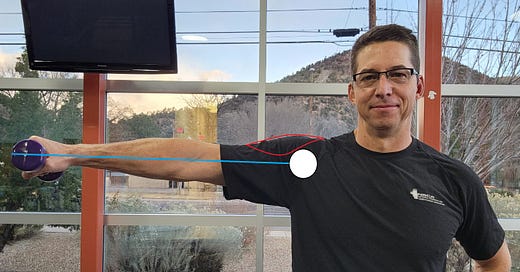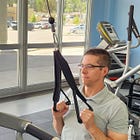This is not medical advice.
That picture above is a straight elbow lateral raise. At 80-100 degrees of flexion or abduction, we sometimes have what’s called a “painful arc” in the industry. It is a test to see if there are rotator cuff issues.
The white ball is the end of the arm bones, and pivot point. The red is the deltoid muscle lifting the arm. The blue line is the length of the lever arm.
Usually after we confirm that you have pain in this arc, and then we have you complete this exercise with added weight. We confirm that the shoulder has very poor leverage, and then we add weight to where leverage is the worst.
Elbows
We have these things called elbows. They bend to improve leverage. They shorten the lever arm by half, and decrease pain and stress at the shoulder.
Full disclosure: When I post this theory among colleagues on social media, it is not received well, to put it mildly. No one agrees with this theory. Everyone else sees no issue with having a painful shoulder submit to poorly leveraged movements, that we don’t perform in real life.
I do not have “evidence” or studies to prove this claim. Just thousands of interactions across 29 years of practice. You should absolutely question all of this.
There are arguments that we reach up in cabinets, and that is true. But we bend our elbows. We don’t do a straight arm windmill overhead. If we did, family members would worry that we were a zombie or robot. (A robot was a good analogy back in the days of Lost in Space, but now that no longer applies. Interesting that robotics engineers respect anatomical leverage better than we do.)
Other examples of poor leverage
We used to have people perform 20 straight leg raises (pictured above), with added weight. That will make for some really strong hip flexors, but it also pulls on the lower back. We don’t kill people with this exercise as much as we used to.
Most of us don’t perform chest flys with straight elbows. Why? Because we intuitively know that leverage is poor, and it doesn’t feel as good as bent elbows. Bent elbows improve leverage and muscle contraction of the pectoral muscles.
Never?
No not never. This exercise is fine for healthy shoulders. But I have seen many cases in women’s aerobic classes, and they hammer this exercises over and over. They want nice looking deltoids, which is great. Yet the rotator cuff balance with other exercises is usually not there. Bent over rows are not going to balance enough of the stress across the joint.
Body builders intuitively perform this with heavier weight, and bent elbows. Better leverage and better muscle contractions. They also have tremendous lats. That’s an important distinction.
Alternatives
Doctor Kirsch had people perform these lateral raises, but they didn’t stop at the painful arc. They completed the full arc overhead, which I think is better. Train the shoulder how to pass the point of poorest leverage and continue overhead.
I prefer this progression for deltoid strengthening.
By the way, I am performing that exercise in the first picture with a rotator cuff tear. I chose not to have surgery, and I did not use that exercise to heal. This is the protocol I used instead.










